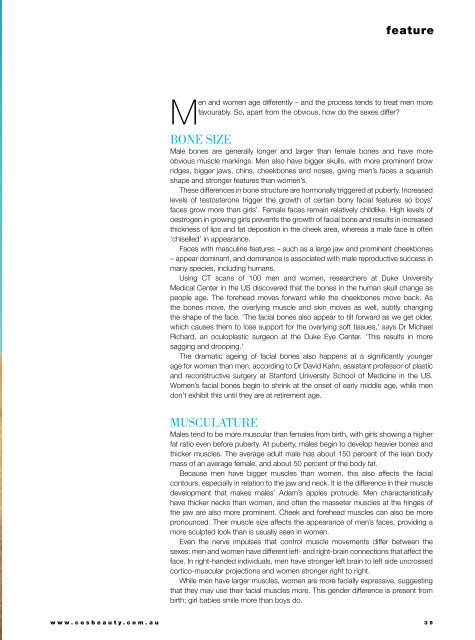Cosmetic Surgery and Beauty Magazine #67
Cosmetic Surgery and Beauty is the go-to magazine for anyone considering an aesthetic procedure. Covering a huge range of treatments with in-depth expert interviews and hundreds of before and after photos.
Cosmetic Surgery and Beauty is the go-to magazine for anyone considering an aesthetic procedure. Covering a huge range of treatments with in-depth expert interviews and hundreds of before and after photos.
Create successful ePaper yourself
Turn your PDF publications into a flip-book with our unique Google optimized e-Paper software.
feature<br />
Men <strong>and</strong> women age differently – <strong>and</strong> the process tends to treat men more<br />
favourably. So, apart from the obvious, how do the sexes differ?<br />
Bone size<br />
Male bones are generally longer <strong>and</strong> larger than female bones <strong>and</strong> have more<br />
obvious muscle markings. Men also have bigger skulls, with more prominent brow<br />
ridges, bigger jaws, chins, cheekbones <strong>and</strong> noses, giving men’s faces a squarish<br />
shape <strong>and</strong> stronger features than women’s.<br />
These differences in bone structure are hormonally triggered at puberty. Increased<br />
levels of testosterone trigger the growth of certain bony facial features so boys’<br />
faces grow more than girls’. Female faces remain relatively childlike. High levels of<br />
oestrogen in growing girls prevents the growth of facial bone <strong>and</strong> results in increased<br />
thickness of lips <strong>and</strong> fat deposition in the cheek area, whereas a male face is often<br />
‘chiselled’ in appearance.<br />
Faces with masculine features – such as a large jaw <strong>and</strong> prominent cheekbones<br />
– appear dominant, <strong>and</strong> dominance is associated with male reproductive success in<br />
many species, including humans.<br />
Using CT scans of 100 men <strong>and</strong> women, researchers at Duke University<br />
Medical Center in the US discovered that the bones in the human skull change as<br />
people age. The forehead moves forward while the cheekbones move back. As<br />
the bones move, the overlying muscle <strong>and</strong> skin moves as well, subtly changing<br />
the shape of the face. ‘The facial bones also appear to tilt forward as we get older,<br />
which causes them to lose support for the overlying soft tissues,’ says Dr Michael<br />
Richard, an oculoplastic surgeon at the Duke Eye Center. ‘This results in more<br />
sagging <strong>and</strong> drooping.’<br />
The dramatic ageing of facial bones also happens at a significantly younger<br />
age for women than men, according to Dr David Kahn, assistant professor of plastic<br />
<strong>and</strong> reconstructive surgery at Stanford University School of Medicine in the US.<br />
Women’s facial bones begin to shrink at the onset of early middle age, while men<br />
don’t exhibit this until they are at retirement age.<br />
Musculature<br />
Males tend to be more muscular than females from birth, with girls showing a higher<br />
fat ratio even before puberty. At puberty, males begin to develop heavier bones <strong>and</strong><br />
thicker muscles. The average adult male has about 150 percent of the lean body<br />
mass of an average female, <strong>and</strong> about 50 percent of the body fat.<br />
Because men have bigger muscles than women, this also affects the facial<br />
contours, especially in relation to the jaw <strong>and</strong> neck. It is the difference in their muscle<br />
development that makes males’ Adam’s apples protrude. Men characteristically<br />
have thicker necks than women, <strong>and</strong> often the masseter muscles at the hinges of<br />
the jaw are also more prominent. Cheek <strong>and</strong> forehead muscles can also be more<br />
pronounced. Their muscle size affects the appearance of men’s faces, providing a<br />
more sculpted look than is usually seen in women.<br />
Even the nerve impulses that control muscle movements differ between the<br />
sexes: men <strong>and</strong> women have different left- <strong>and</strong> right-brain connections that affect the<br />
face. In right-h<strong>and</strong>ed individuals, men have stronger left brain to left side uncrossed<br />
cortico-muscular projections <strong>and</strong> women stronger right to right.<br />
While men have larger muscles, women are more facially expressive, suggesting<br />
that they may use their facial muscles more. This gender difference is present from<br />
birth; girl babies smile more than boys do.<br />
www.cosbeauty.com.au 39


















